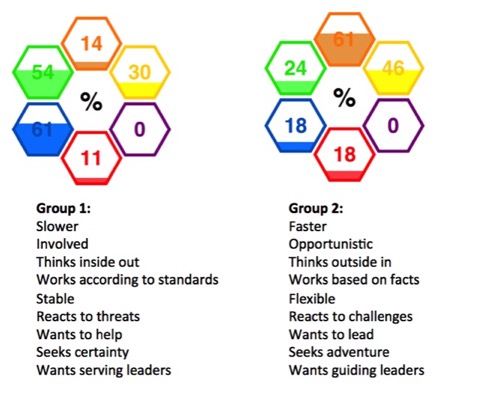A random group of a thousand Dutch people shows a very different pattern than a random group of Belgians. This is true, Belgians have higher scores in blue and purple. But it becomes even more interesting when we compare Dutch teachers and accountants with Belgian teachers and accountants. Then it becomes clear that the difference between teachers and accountants is much greater than the difference between the Dutch and Belgians. For large cultural difference you then don’t need to leave the country. In every culture we see tremendous differences between subcultures. And that’s a good thing: just imagine if bookkeepers were like sales people!
And speaking of sales people, when you take a closer look at this group you will find cultural difference between seller-groups. Sales people in the business-to-business sales segment for instance tend to score higher in green than the sales people in the business-to-consumer segment; they are more driven to maintain relationships. Presumably that is more effective in their world.
In the field you find that departments within organizations each have their own culture. The Finance department is populated by people with very different drives from the people working in the Sales department. And it has to be that way, because the tasks are very different and ask for people with different drives. An organization of some size then consists of different subcultures, that each show a different measurement result. These indicate what weight the drives in the group have. In this measurement we don’t use a mathematical average, but a weighted average that takes into account the dynamic between drives and the interaction between people in the group. Therefore one person with a solid red drive will have little impact on the group as a whole if the others score zero in that drive, but conversely the weight of the drive will increase significantly if each member scores in red.

The differences between groups can, just as between individuals, be extraordinarily great. With regularity we find that within an organization there are departments which have next to nothing in common. Their cultures are completely different. Above you see an example. You see two completely normal groups, but it is clear that on a whole host of issues they don’t agree with each other.
The team pattern is determined based on the drives of all team members. The team pattern is not just a mathematical average, but is determined by the application of group dynamic logic. The calculation takes into account how much people are influenced by the group, since the measured drives allow predictions about how people will adapt to each other.
The team pattern result is created to judge whether a group course correction is needed, and if so, in what areas. These results can be used on different levels:
- the group can see for itself in what areas they are strong or weak, and where the biggest risks to effective function are;
- leadership of the group can see in what way to guide the group to ensure sustainable functioning;
- top management can see to what degree self- guidance of a group is possible, and what goals should be given to the group leader.

 discovering personal drives & team culture
discovering personal drives & team culture